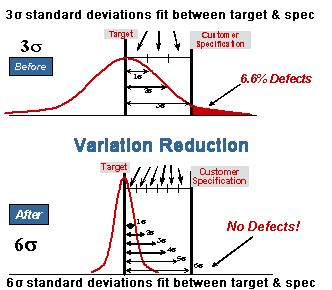Lean and Six Sigma Approach
A methodology to improve the capability of business processes by reducing variability and elimination of defects in any process from transactional to product to service.

99.99966% accuracy - 3.4 defects per million is a systematic methodology to improve the capability of business processes by reducing variability and eliminating defects in any process from transactional to product. It is a vehicle for strategic change and organizational approach to performance excellence. Six Sigma creates transformational change throughout the organization, processes, culture and customers. It creates transactional change by applying tools and methodologies targeted at reducing variation and drastically improving process performance.
The process begins by defining the problem, those things Critical To Quality (CTQ). Then measure the performance of those CTQs. Next, analyze the gaps between actual and planned output to find root causes of the problem and determine which problems have the most impact. With the causes identified, you're ready to improve the situation by initiating change. Finally, you need to ensure that the change lasts. The final step initiates measures to sustain the improvements you've made for long-term control. The goal then is to get to the root out the problem and ensure the solution is repeatable and sustainable.
The process begins by defining the problem, those things Critical To Quality (CTQ). Then measure the performance of those CTQs. Next, analyze the gaps between actual and planned output to find root causes of the problem and determine which problems have the most impact. With the causes identified, you're ready to improve the situation by initiating change. Finally, you need to ensure that the change lasts. The final step initiates measures to sustain the improvements you've made for long-term control. The goal then is to get to the root out the problem and ensure the solution is repeatable and sustainable.
|
Our methodology engages all functional areas of an organization through the use of data, data, and more data. The Six Sigma process also identifies the critical components to improvement. The thoroughness of analysis allows improvement teams to find the most critical cause of "Y" or the unacceptable performance. Focusing on the “x’s” will allow identification of those “critical few” which are causing the undesired outcome. Teams will know what to address “first” to achieve quicker results.
|
6 Lean and Sigma ToolsStatistical Process Control
Design of Experiments Process Analysis Organizational Development Project Management FMEA |
Key Benefits 20% Improvement in Margin
2%-18% Increase in Capacity 10%-30% Reduction of Capital Spend |
Phased Model
DefineIdentify the Problem
Define Requirements Set Goal |
MeasureValidate the Problem/Process
Refine Problem/Goal Measure Key Steps/Inputs |
AnalyzeDevelop Causal Hypotheses
Identify "Vital Few" Root Causes Validate Hypothesis |
ImproveDevelop Ideas to Remove Root Causes
Test Solutions Standardize Solution and Measure Results |
ControlEstablish Standard Metrics Maintain Performance
Correct Problem as Needed |
Six Sigma was pioneered by Motorola in 1980's where they discovered that products with high first-pass yield (the amount of product that made it through defect-free) seldom failed in use. This power philosophy promotes excellence in all business processes to improve productivity, profits, and customer satisfaction. The Methodology espouses a 5-phase process for continuous improving quality by reducing inherent variability.
Process Redesign Model
DefineIdentify Specific or Broad Problems
Define Goal/Change Vision Clarify Scope & Customer Requriements |
MeasureMeasure Performance to Requirements
Gather Process Efficiency Data |
AnalyzeIdentify "Best Practices"
Process Capability Refine Improvement |
ImproveDesign New Process
Implement New Process, Structure, System |
ControlEstablish Measures & Reviews to Maintain Performance
Correct Problems as Needed |




